| In February 1942, the 16th Infantry left its permanent Camp at Fort Deven, Mass., for 4 months of maneuvers training at Camp Blanding, Florida. Following these maneuvers, the 16th spent approximately a month at Fort Benning, Georgia, in garrison, where normal training activities were carried on; and near the end of June, proceeded to the staging Area at Indiantown Gap, Pennsylvania. On June 30, 1942, Company "E", among the first group in the Division to head overseas, proceeded to New York City and loaded on Army Transport number 150 at 2000 hours. The ships name was The Duchess of Bedford, affectionately referred to by the men in the Company as "The Dirty Duchess", for reasons all who have ridden on troopships will understand. Thus, on a summers evening there began quietly and without fanfare or incident, an overseas career that was to take Company "E" through the invasions of three hostile shores, participations in major battles in upwards of a half-dozen countries, and to last for over three long years.
The rather large convoy suffered no accidents; there was gun drill and fire drill and boat drill; the usual number of men were sea sick, the usual number of small fortunes were won and lost, and on July 12, the "Dirty Duchess" steamed into the British port of Liverpool. Debarkation was carried out the next day�the Company moved by motor and marching to Tidworth Barracks near Salsbury, England. For the next two months there was a full training schedule, inspections, night problems, and long hikes through picturesque countryside, and through the not so picturesque rain and fog. But there were weekends in London, and liberal passes in the evenings to the small towns around Tidworth. In late September, Company "E" left for Avnesbury, Scotland, and boarded the British transport "Reina Del Pacificio", for training on the River Clyde. After more training on the "Orbita" and duties in the harbor on the Clyde Bank, on October 26, Company "E", aboard Ship L-12, left the Scottish port for a landing operation, destination unknown. As the convoy steamed past the straits of Gibraltar and headed for the "Dark Continent", the men realized that they were part of the Allied Invasion of German held North Africa. While still at sea, two air attacks were beaten off, and one enemy submarine sunk. Then at 1100 hours, November 8, the landing was made on ARZEW BEACH, without casualties, and the Company moved inland over 15 miles of sand to bivouac at LOGRANDE. The next day Company "E" took up the advance guard for the Battalion's march on ORAN. The first sign of the enemy came at 2305, when a flare was sighted and 75mm artillery fire began falling to their rear. The advance continued, and at 2315, the enemy opened up with machine gun and rifle fire, wounding 3 men in the point. At 2335, as the Company deployed to meet this resistance, Pfc Smith became the first man in Company "E" to die a hero's death in the war, when he was killed by enemy fire as he emptied his automatic rifle into the enemy line. Another bad piece of luck occurred immediately afterwards�enemy shell fire ripped into a high-tension wire overhead, which fell on and killed 3 men, in addition to lighting up the whole area and disclosing the disposition of every man. The Battalion formed a new line, and the next day drove on to ORAN, which surrendered. Road blocks and pickets were set up and operated, and raids were carried out for Nazi sympathizers. Awards were presented; a ceremonial parade held with units of the French Army, the Company moved to VALMY, ALGERIA to form a security guard for an airbase. The men got their first look at foreign women�Arabs, who were off limits, and French, who weren't�there was plenty to drink, souvenirs to buy, and the amazing filth and ability to steal of the Arabs was a source of constant wonder. The first Christmas away from home will be hard to forget�wading knee deep mud to the kitchen in anticipation of a promised turkey dinner with "all the trimmins", they were greeted with cold salmon. The howls of rage were loud and long. The turkey came three days later. The end of January, 1943, found Company "E" back in the fight near REBAA, TUNISIA, and there were skirmishes and patrols for a month, leading up to a defensive position at KASSERINE PASS. The Jerries attempted to break through, they were stopped and the Battalion pulled back for a rest, when Jerry struck again, this time with all he had. The Battalion was thrown back into the defense, and though subjected to heavy 88mm and tank fire, assisted in completely routing the enemy and practically annihilating the 10th Panzer Division. Continuing to EL GUETTAR, Companys "E" and "F" made the famous bayonet charge to take Hill 606, driving the enemy from dug in positions with hand grenades, and stopping only when the Company Commander and one platoon were captured. In the attack of Hill 374, Lt. General McNair, then Army Ground Force Commander, was injured while in Company "E" Area, which was being subjected to heavy shelling. When the last of the Italians and Germans gave up on May 8, Company "E" was in MATEUR, but immediately returned to ARZEW BEACH, the site of their original landing and began practicing beach landings again, going over the side by means of nets. The weather was muddy murderous. After a month of this, the U.S.S. Thurston carried them to STAOUELI, near ALGIERS for a period of hikes, inspections, and British extended order drill. It was still hot, but here there were passes to ALGIERS, where there was ice cream, beer, and not a little excitement, if you ventured into the Arab quarter after dark. In July came the invasion of SICILY, and Company "E" hit the beach at GELA at 0200, July 10, part of the first battalion landed. The assistance promised in the form of planes and paratroopers failed to materialize, so sheer courage was all that helped the Company storm the beaches through enemy mine fields, artillery, and small arms fire, and gain the high ground beyond. The foot troops drove forward for several miles, and before any support could be landed behind them, the enemy counterattacked, and heavily�with two Battalions of tanks, part of which raced down the beaches to come behind them. For the action that followed, the Battalion received a Presidential Citation for heroic action. With some assistance from the Naval guns offshore, a few anti-tank guns, and skillful handling of the bazookas by men who had the courage to let the tanks pass over them in a foxhole, then rise and shoot the tank from the rear, the overwhelming odds of the enemy were soon diminished and the attack routed. The battle for SICILY lasted 28 days, but it was done so quickly by maintaining a killing pace. They marched at night and fought all day, over torturous terrain, in scorching weather. Chow and ammunition were brought up by donkey, if at all. The fighting was sporadic, but bitter, and consisted mostly of skirmishes for road centers. Company "E" and the rest of the second Battalion took TROINA after 2 other units had tried and failed; they took NICOSIA and RANDAZZO, which was the last line of defense of the faltering enemy. Air power had helped, as in the attack on TROINA when B-26's and P-51's softened up the objective in front of the troops, but SICILY was won principally by the dough's literally marching the shoes off their feet. The battle over, Company "E" took up life in pup tents at LICATA, near PALMA, SICILY, and began to inspect the surroundings, which were extremely inauspicious. The natives were dirty and thieving, the country devoted mostly to raising cattle and horses, and the one bright spot in the picture, were the excellent wineries, and vineyards, often 50 or 60 acres in extent. There was training and daily hikes, three retreat parades weekly, with movies at night and Company parties were red Sicilian wine flowed freely. The high spot was the visit of Bob Hope and his troupe in August. On October 21, the HMS Maloja was boarded, and until two days after she sailed, there was considerable conjecture as to the destination�some thought it would be to invade Italy, some expected to return to the States. But just over a year after leaving England, it was LIVERPOOL again, with a British band playing a welcome. Company "E" moved into Nissen huts at WALDITCH, a half mile from the Channel, near BRIDPORT, for the winter. There were hikes and films, rain, MP detail in town, liberal passes, the people were friendly, the First Sgt. got married, there was turkey on Turkey Day and again on Christmas in the big Battalion mess hall, with ice cream and beer besides. There was cool weather, firing on Symondsbury and Eype Down ranges, a lecture on "What We Will Find in Europe", training in street fighting in a bombed out section of the port town of WEYMOUTH, church on Sundays in BRIDPORT; in short, the men found England the best place to be next to home. In January 1944, British General Montgomery reviewed the troops on the cricket field at BRIDPORT, and told them that of all the American Divisions he'd seen, he'd rather fight with the 1st US Division. In February, they went 86 miles by motor to BARNSTABLE for assault team training, amphibious operations, attacks on fortified positions, boat landings and obstacle courses. On the 24th there was a beach landing by the entire Regiment. In March, the Company boarded the U.S.S. Henrico at WEYMOUTH for another practice landing and attack inland. The bright spot in this picture was the chow served by the Navy, which was excellent. Back in WALDITCH, James Cagney and cast entertained with "Keep 'Em Rolling". A Battalion rifle match was won by Company "E" and on April 2, General Eisenhower came around to inspect, present awards and make a speech. Any illusions of returning to the States were dispelled when he said, "The First Division will be one of the last to go home. If nothing else, I'll just keep you around for good luck." From this time on the Division was alerted for the invasion of the continent. They went to MARTINSTOWN to train, the swift water there, boarded the U.S.S. Henrico, and assaulted "Able Red" Beach once, then again. General Heubner, the Division Commander, made a speech. The Company was organized into 5 assault sections and trained that way, each section equipped with flame throwers, and bangalore torpedoes, and with its own base of fire. On June 1, they boarded the U.S.S. Henrico again, and when it sailed out from WEYMOUTH harbor on June 5, D-Day and H-Hour were announced. The big show was on. There have been many more complete accounts of what happened that day than it is possible to present here. Suffice it to say that Company "E" in the assault wave, landed on Easy Red Beach at 0645 in the face of murderous fire. Two-thirds of the Company were immediate casualties, but those remaining kept wading right into everything the enemy had and took their objective, which provided the only exit from the beach that the entire Fifth Corps had for 48 hours. It is an obvious fact that Company "E", as much as, if not more than any other unit, seemingly by strength of will and courage alone, saved the entire beachhead from being thrown back into the sea. It was an experience few men under went and lived, and for a month afterwards, those who did, remained almost in a daze. The Battalion broke through to COLLEVILLE-SUR-MER, advanced to VILDAY, and on D + 4 to CORMOLAIN, where the kitchen came up, killed a cow and cooked steaks. The Company remained here for about a month, re-organized, was given re-inforcements and a chance to clean up. But the Heinies still interfered with sleeping by crawling down the hedgerows near the positions and firing machine guns all night. July 25th 1944, known as the day of the break through, planes flew over the Company for 3 hours; 300 P-51's began it by dive-bombing and strafing enemy positions to the front, then Flying Fortresses and Liberators bombed in flights of 75, and the B-25s and B-26s did their work of low-level bombing. It was a real show, and the race across France was on. Company "E" fought to take MAYEN, which started the forming of the FALAISE GAP, where the Regiment faced enemy to the north, south, and east. At MORTAIN there was another pocket, and at the Marne, just east of Paris, two platoons of the Company were surrounded by enemy forces fleeing that city and fought heavily until relieved by Company "G" coming in on tanks. But much of this period was enjoyable; they were seeing France, and the population often ran out with wine to hand up to the men on the trucks and tanks. Only the pace was too rapid for a chance to linger and cultivate the acquaintance of the mademoiselles. September 5th 1944 found Company "E" entering Belgium, where one of the most notable battles of the war occurred, near the city of MONS. A jam-packed enemy convoy, covering the road for 25 miles, had just been strafed by allied planes. Company "E" ran head-on into this mess, and the resulting confusion was tremendous. The Company quickly set up a perimeter defense; every man in the organization began firing, and the basic load of ammunition was expended in 3 hours. They were surrounded on all sides by frantic Germans, seeking to escape, but themselves only suffered 2 casualties and by noon the next day had taken 1500 prisoners, the largest bag of a single Company in the Division. Needless to say, there were beaucoup pistols and loot gathered. Belgium was crossed in 5 days. September 14th 1944, Company "E" entered Germany. They took positions in pill boxes on a ridge near EILENDORF, east of AACHEN, and began hearing their first artillery fire since the break through across France. But it was enough to make them forget there had been a lull. For 38 days, in rain and fog that cut observation to a minimum; the Company beat off almost continuous strong counterattacks, and were subjected to terrific shelling. Casualties were frequent, the only food that could be brought up was sandwiches and coffee, but in an almost untenable position, the Company yielded not an inch. October 1944 , there was a 5-day rest at BRAND, GERMANY. The men were billeted in houses, there were movies and showers and beer, and the doughnut wagon paid a visit. Then it was back in the line again at STOLBERG, and when relieved by the 104th Division, it was to jump off in the season's first snow attack near HAMICH, GERMANY. The two weeks which followed are acknowledged by almost everybody as the roughest battle of all, next to the beach on D-Day. It was the drive through the HURTGEN FOREST, against a stubbornly resisting enemy, under artillery and machine gun fire day and night. The sun never shone though the trees and the men were without overcoats or blankets for the first 3 days and nights in the cold, wet woods. A fox-hole was little protection from artillery, for almost every round was a tree-burst. There was no rest or warmth, and casualties mounted. When the end was reached at LANGERWEHE, the Company pulled back to one of the towns they had taken, HEISTERN, to receive reinforcements. December 5th found them in MUTZENICT, and some were sent to EUPEN for showers. December 13th 1944.The Division began to pull off the line to the vicinity of HERVE, BELGIUM for its first rest since the D-Day invasion. Company "E" moved into THIMISTER and on the 15th, held a ceremony to present the awards of Bronze and Silver Stars. They were in the rest area for 3 days�and then came the Battle of the Bulge. Still grumbling at their luckless fate, the Company hit the north shoulder of the Bulge at SOURBROUT, in the MONSCHAU area, then moved down to WAIMES, and set up a strong defensive position. For the next month, the enemy knocked himself out trying to break through in this area. His daily punches at the line with armor were stopped by the mine fields in front of the Company, and the Division artillery took its deadly toll of attacking infantry. But the men suffered too, for their fox holes filled with snow which covered their positions to a depth of 4 feet or more. One man was lifted out of his "snow hole" and carried to the aid station, frozen in a sitting position. January 16th 1945, the Company began the drive to cut down the Bulge by taking FAYMONVILLE, and 3 days later took SCHOPPEN in a blinding snowstorm. Half of the weapons in the Company froze and wouldn't fire, but the Jerries were found in their holes in the same predicament. In the days that followed the enemy used American .50 and .30 caliber machine guns and 81mm mortars against them; it was bitter cold in the woods, as evidenced by the fact that in one day alone, 22 men in the Company had to be evacuated as frost bite casualties. Sometimes there were as few as 5 fighting men per platoon. A series of attacks which began by Company "E" crossing the Roer River and taking KREUZAU on Feb. 26, were among the most successful ever carried out by the Battalion. Two or three towns a night were taken, against tough resistance, by employing good strategy and driving boldly and aggressively, until March 9, when after a day's street fighting, Bonn fell, and the Division was sitting on the west bank of the Rhine. But there was a bridgehead across the river down at REMAGEN, and the 1st Division raced across to expand it. Company "E" went in on the extreme north flank, took the town of ROTT in house to house fighting, and HENNEF, on the Seig River. There was a stiff resistance, and plenty of opposing armor, but the drive progressed by leaps and bounds and the Company took WILGESDORF, and closed in at GESKE to meet units of the 9th Army and form the Ruhr pocket. The spearheading armor was stopped at the WESSER RIVER. There were no bridges for the tanks to cross on, so at 0400 on the morning of April 8, the men of Company "E" carried their assault boats down to the waters edge and stormed across in the face of withering fire, suffering 6 casualties, but clearing the way for the tanks to again break loose. For three weeks then, the fighting was over terrain remindful of Sicily�advances were difficult even when unopposed�it was cold and rainy. ST. ANDREASBERG fell to Company "E", and soon the failing enemy began surrendering in groups of as large as whole Companies. On the day the HARZ MOUNTAINS campaign ended, 600 walked into the Company lines to give up. Having fought their way completely across Germany, the men found themselves in CZECHOSLOVAKIA, and members of the 3rd Army. Though many units had fought their last battle already, there remained for Company "E" one more�on May 6, they drove 15 miles through rain and mud to capture 80 prisoners and 12 towns. That there was considerable opposition is attested to by the fact that there were 6 casualties. V-E Day found the Company in CHULM ST. MARI, and the announcement was immediately followed by everyone getting drunk. For several days prisoners streamed in by the hundreds. The natives were more than friendly, inviting the men into their homes and offering them their own beds. The girls were pretty, there was plenty to drink, and there were no-nonfraternizing restrictions, which made for an enjoyable month before it was time to return to Germany assume and occupational duties. Only one man who came overseas with Company "E" originally is still with the organization, but all those who are or have ever been apart of it, have a right to be proud. |
 |
| HISTORY OF COMPANY "E", 16TH INFANTRY.
1942-1945 by LEONARD E. RICHARDSON 1st Lt., 16th Infantry |
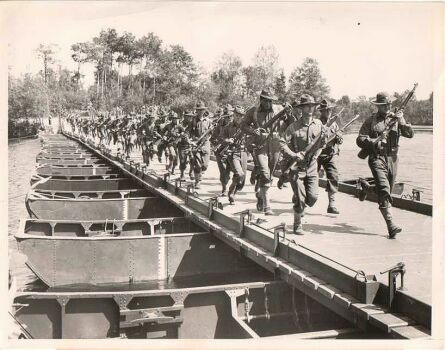 |
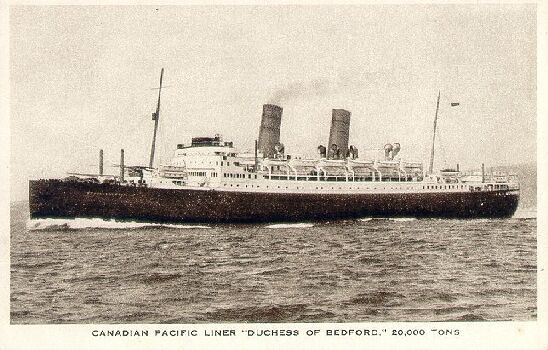 |
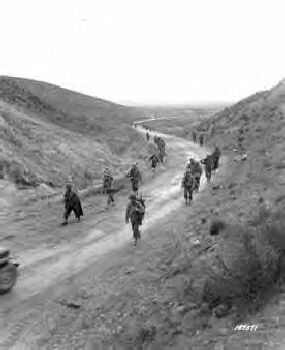 |
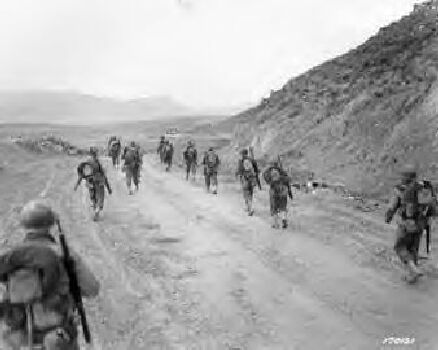 |
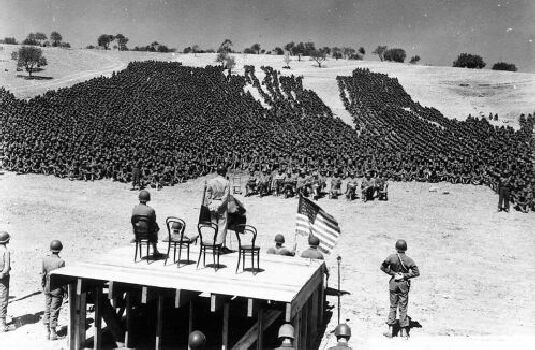 |
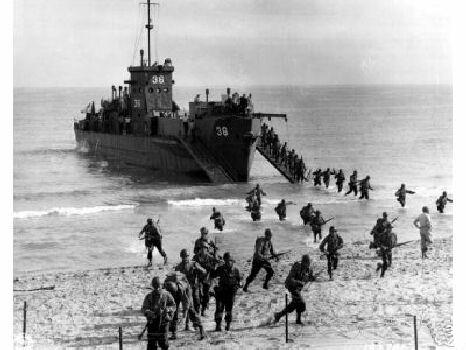 |
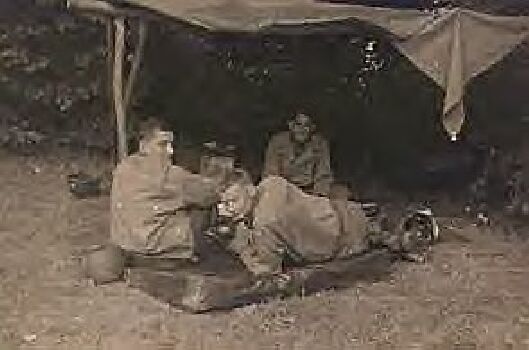 |
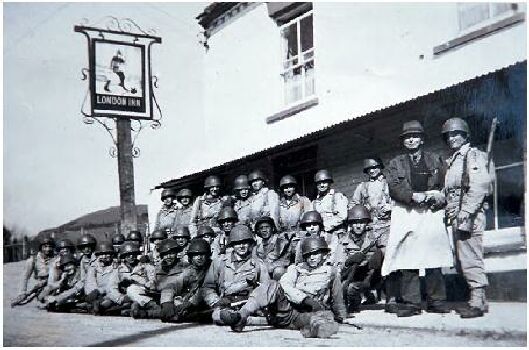 |
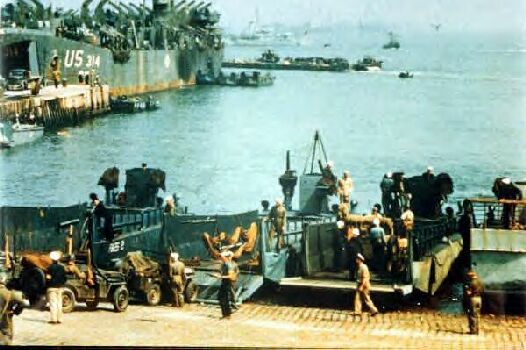 |
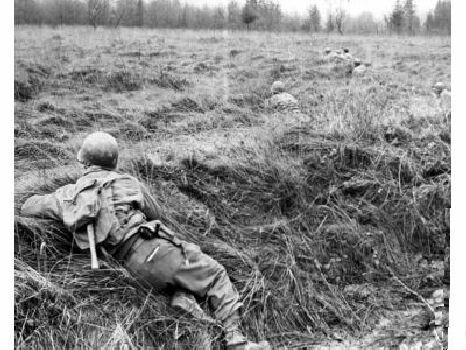 |
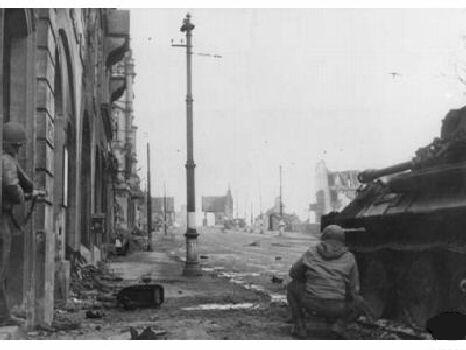 |
 |
 |
| Photo at left, from left to right:
Col. George A. Taylor, 16th Infantry commanding officer; Major Carl W. Plitt, S-3; Major Charles E. Tegtmeyer. Regimental Surgeon; Major John H. Lauten, S-2; and Captain William Friedman, S-1. Photo taken during amphibious exercise in England, early 1944. |
| Colonel Frederick W. Gibb, commander of the 16th during the European campaign. |